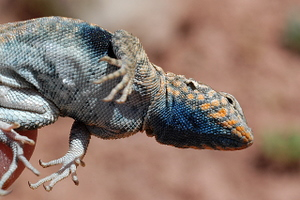Where it is most common, the side-blotched lizard often is the most abundant reptile in its habitat. Population density commonly reaches hundreds per acre.
Photo Credit: Geoffrey A. Hammerson
Uta stansburiana
Common Name: side-blotched lizard
Other Common Names: common side-blotched lizard
Animal Guild: Reptile
Class > Order > Family: Reptilia > Squamata > Iguanidae
What does the species look like?
Side-blotched lizards are variable in color and pattern, being spotted, blotched, or unpatterned, depending on location. The scales along the middle of the back are of uniform size. Each side of chest has a dark blotch (a large blue-black streak is present in some males). The throat of adults is blue, with an orange rim in some regions (colors less intense in late summer). At least one scale on top of the head behind the eyes is obviously larger than the scales along the middle of the back. Maximum snout-vent length is about 2.5 inches (6.3 cm); average size of adults increases from north to south across the range. Mature males have two hemipenial swellings (these are the copulatory organs) on the underside of the tail base and a pair of enlarged scales behind the vent on the underside of the tail.
Where is the species found?
States & Provinces
AZ, CA, CO, ID, NM, NV, OK, OR, TX, UT, WA
Distribution
Range extends from central and northeastern California, central and eastern Oregon, central Washington, southwestern Idaho, Utah, and western Colorado southward to the tip of Baja California, northern Sinaloa, and northern Zacatecas, Mexico, including many islands along the Pacific coast of Baja California and in the Gulf of California. The single known population in Montana may be native or possibly was introduced. Elevational range extends from below sea level in desert sinks to about 9,000 feet (2,750 meters).
Habitats include a wide variety of arid and semiarid situations with scattered bushes and/or scrubby trees; soil may be sandy, gravelly, or rocky; the species is often found in sandy washes with scattered rocks and bushes.
General Phenology and Life History
Activity occurs during daylight hours, mostly from March to November in the north. In the southern part of the range, active lizards may be seen in any month. In most of the range, bobbing courtship displays and mating begin in spring as lizards emerge from hibernation. Reproductive females produce 1-3 clutches of 1-5 eggs in the northern part of the range, 2-7 clutches of 1-8 eggs in the south. Egg laying begins as early as March in the south, by mid-April in Colorado, and extends through July or August in many areas. Females bury eggs in sandy soil. Eggs hatch in late July and August in Colorado, as early as late June in Texas, Nevada, and Idaho.
Which phenophases should I observe?
Do you see/hear...?
Activity
Individuals on land More...
For abundance, enter the number of individual animals observed in this phenophase.
Feeding For abundance, enter the number of individual animals observed in this phenophase.
Development
Young individuals For abundance, enter the number of individual animals observed in this phenophase.
Dead individuals For abundance, enter the number of individual animals observed in this phenophase.
What do these phenophases look like?
There is currently no photoguide available for this species. If you'd like help us create one, use the guidance document and species template provided here . Then send it via email to education@usanpn.org when it is complete.
